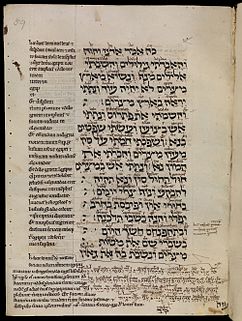Loading AI tools
Last chapter of the Book of Ezekiel From Wikipedia, the free encyclopedia
Ezekiel 48 is the forty-eighth (and the last) chapter of the Book of Ezekiel in the Hebrew Bible or the Old Testament of the Christian Bible.[1][2] This book contains the prophecies attributed to the prophet/priest Ezekiel,[3] and is one of the Books of the Prophets.[4] Chapters 40-48 give the ideal picture of a new temple. The Jerusalem Bible refers to this section as "the Torah of Ezekiel".[5]
| Ezekiel 48 | |
|---|---|
Daniel 1 → | |
 Book of Ezekiel 30:13–18 in an English manuscript from early 13th century, MS. Bodl. Or. 62, fol. 59a. A Latin translation appears in the margins with further interlineations above the Hebrew. | |
| Book | Book of Ezekiel |
| Hebrew Bible part | Nevi'im |
| Order in the Hebrew part | 7 |
| Category | Latter Prophets |
| Christian Bible part | Old Testament |
| Order in the Christian part | 26 |
This chapter contains Ezekiel's vision of the land allocated to the twelve tribes (Ezekiel 48:1-7 and 23–29), the sanctuary (verses 8–14), the city and its suburbs (verses 15–20), the prince (verses 21–22) and the dimensions and gates of the city (verses 30–35).[6] The vision was given on the 25th anniversary of Ezekiel's exile, "April 28, 573 BCE",[7] 14 years after the fall of Jerusalem and 12 years after the last messages of hope in chapter 39.[8]
The original text was written in the Hebrew language. This chapter is divided into 35 verses.

Some early manuscripts containing the text of this chapter in Hebrew are of the Masoretic Text tradition, which includes the Codex Cairensis (895), the Petersburg Codex of the Prophets (916), Aleppo Codex (10th century), Codex Leningradensis (1008).[9]
There is also a translation into Koine Greek known as the Septuagint, made in the last few centuries BC. Extant ancient manuscripts of the Septuagint version include Codex Vaticanus (B; B; 4th century), Codex Alexandrinus (A; A; 5th century) and Codex Marchalianus (Q; Q; 6th century).[10][lower-alpha 1]
The New King James Version divides this chapter into two sections:

This section deals with the allotments of the land north of Jerusalem, as the land is divided by borders running east to west into parallel strips of unspecified width.[12] The distribution is different from the earlier portions of the tribes of Israel, which were named after the sons of Jacob (Genesis 35:22–26 also called "Israel") and his two grandsons, the sons of Joseph (cf. Ezekiel 47:13).[12]
Hethlon has been identified as modern Heitela in Syria,[14] although theologian Tremper Longman claimed recently that its exact location is still unknown.[15]
The tribe of Joseph receives two portions, while the priestly tribe of Levi receives none, maintaining a total allotment of twelve.[16][17]
This part gives more details on the piece of land described in Ezekiel 45:1–8, which consists of the sacred reserve, the city reserve and the prince's allotment.[18]
The distribution of the land follows the style of verses 1–7 for the areas south of the central strip, with the tribe of Gad receiving the southernmost allotment, whereas formerly only the portions of the tribes of Judah and Simeon lay south of Jerusalem.[19] The section has a proper conclusion in verse 29.[19]
The last section of the book records the vision of the "structure like a city" seen by Ezekiel in Ezekiel 40:2.[20] These verses apparently are added from a different source, focusing the city gates on each of the four sides, and each gate is named after a certain tribe (cf. Revelation 21:12f) to complete 'a picture of perfect order and harmony'.[19] This new city is different from the Jerusalem in history, because the gates of the post-exilic Jerusalem in Nehemiah time were carefully noted, yet none was named after the tribes (cf. Nehemiah 3), although in the pre-exilic period there were a Benjamin gate and an Ephraim gate (Jeremiah 37:13; 2 Kings 14:13), but both were on the north side, not the east side, of the city.[20] Also, in the new city, Levi stands as one of the twelve tribes with its own gate, whereas Ephraim and Manasseh are represented by a single "Joseph" gate.[20] The order of gate naming seems to have its own logic, with the children of Leah on the north (Judah, Levi and Ruben) and south sides (Simeon, Issachar and Zebulun), the children of Rachel on the east side (Joseph and Benjamin, together with Dan, the eldest son of Bilhah, Rachel's handmaid) and the remaining children of the concubines (Gad, Asher and Naphtali) grouped together on the west.[20] The arrangement recalls the order of tribal camps surrounding the tabernacle, three on each of the four sides (Numbers 2), that brings the clear idea of "diverse but united people organized around a sacred point of reference," that is "the divine presence in its midst".[21]
Seamless Wikipedia browsing. On steroids.
Every time you click a link to Wikipedia, Wiktionary or Wikiquote in your browser's search results, it will show the modern Wikiwand interface.
Wikiwand extension is a five stars, simple, with minimum permission required to keep your browsing private, safe and transparent.